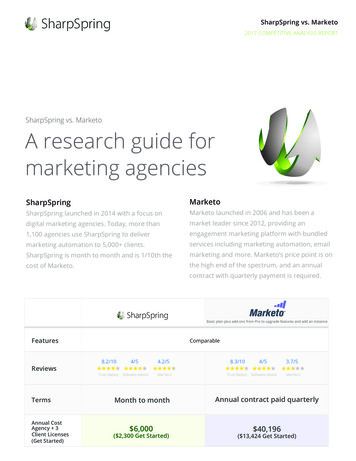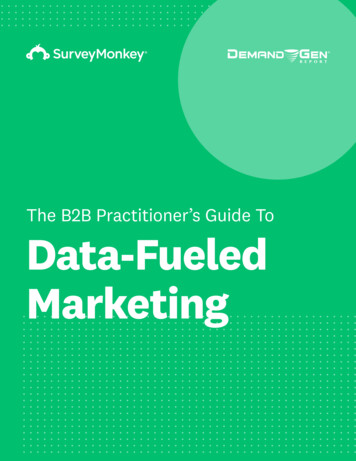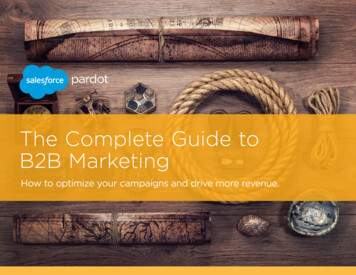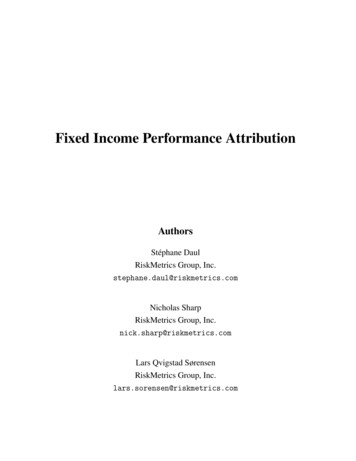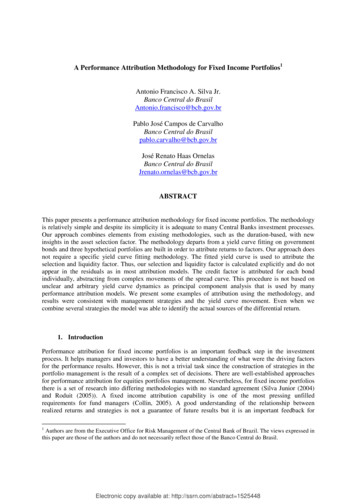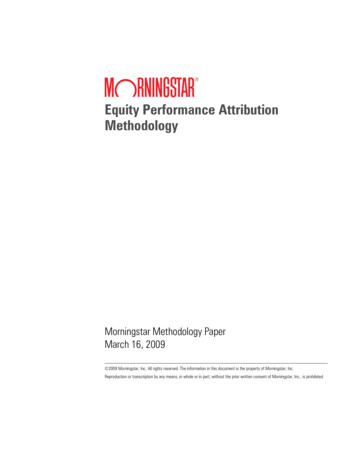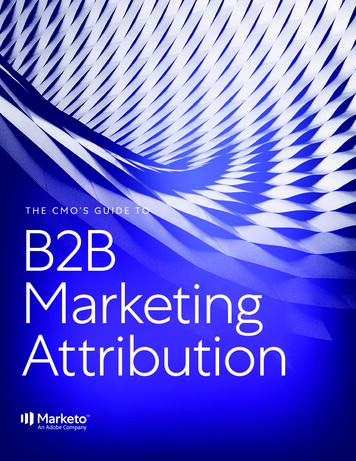
Transcription
THE CMO’S GUIDE TOB2BMarketingAttributionT H E C M O ’ S G U I D E TO B 2 B M A R K E T I N G AT T R I B U T I O N1
WHAT ’ SINSIDE:03Introduction05Understanding B2B marketing attribution for CMOs07How is marketing attribution different than other marketing tools?11Which marketing attribution model is right for your organization?15How does attribution fit in the marketing stack?21Selling attribution to the C-suite22How we’re helping our customers succeedT H E C M O ’ S G U I D E TO B 2 B M A R K E T I N G AT T R I B U T I O N2
IntroductionT H E C M O ’ S G U I D E TO B 2 B M A R K E T I N G AT T R I B U T I O N3
When trying to determine whether your campaigns aresucceeding, marketing teams often focus on tracking activitieslike lead form captures, email opens, and links clicked. Afterall, these activities are a way to examine how potential buyersare engaging with your content.Senior management, however, isn’t asinterested in activity-based tracking asit is in return on investment (ROI)-basedThat’s where marketing attribution comesin. The right marketing attribution solution,integrated with your existing marketingmeasurement. Senior leaders want tosee tangible results. And when yourmarketing team tracks activities and salestracks revenue, this can result in a lack ofalignment between departments.automation platform and your customerrelationship management (CRM) system,allows marketing to track both activitiesand ROI, increasing its credibility andpositioning it as a strategic partner tosenior management.T H E C M O ’ S G U I D E TO B 2 B M A R K E T I N G AT T R I B U T I O N4
UnderstandingB2B marketingattribution forCMOsT H E C M O ’ S G U I D E TO B 2 B M A R K E T I N G AT T R I B U T I O N5
What is marketing attribution?B2B marketing attribution, at its simplest,is about connecting marketing and salesdata. By connecting marketing to salesdata—where deals close and revenuemetrics are held—the marketing team nolonger has to guess their revenue impact.Every deal can be tied back to specificmarketing programs.Without proper attribution, marketers areforced to use metrics that serve as proxiesfor revenue (visitors, leads, conversions,etc.). From there, they estimate whatpercentage of visitors turn into leads, andso on, without a clear view of how muchrevenue they are driving. The higher in thefunnel the metrics are, the less they tell youabout quality, which makes it difficult todrive actionable results.In Bizible’s 2018 State of Pipeline MarketingReport, marketers say that pipeline andROI are the top two metrics they use tomeasure performance. However, a CMOT H E C M O ’ S G U I D E TO B 2 B M A R K E T I N G AT T R I B U T I O Ncan’t meaningfully drive and optimize forrevenue when they’re not using the rightattribution solution. If that’s the casefor you, it might be the right time for anattribution audit.With the right B2B marketingattribution, marketers receivecredit and can optimize based onactual full-funnel performance data.Revenue accountability and full-funneltransparency result in more efficientmarketing content, audience targeting,channel decisions, budget allocation,and more—all from a revenue-producingperspective.Good B2B marketing attribution includesat least two key components: a multitouch model and connection to the CRMsystem. This allows for a multitude ofadvantages, which are discussed in thefollowing sections.6
How is marketingattribution differentthan othermarketing tools?T H E C M O ’ S G U I D E TO B 2 B M A R K E T I N G AT T R I B U T I O N7
Many marketing tools already used by mostorganizations claim to do attribution or atleast some version of it. It’s also naturalto want to use these tools since you’vealready committed to them—but, when youtake a closer look, they don’t really do whatyou need.Web and other channel-specific analyticsOne limitation of web analytics (e.g.,Google Analytics) and other channelspecific analytics (e.g., Facebook Insights)is that they only track form conversions,which are a proxy for revenue in a B2Bsituation. It requires quite a bit of hackingto create a usable attribution solutionthrough URL parameters, event setting,and connecting spreadsheets full ofchannel-specific data in order to dive intoBUYER JOURNEYM O N D AY WWWBecause the attribution is decentralized,marketers risk double-counting creditwhen hacking a solution. For example,if a visitor clicks on a Google Adsadvertisement on Monday, a Facebookad on Wednesday, and then buyssomething for 100 on Friday, both yourGoogle Ads data and your Facebookdata will claim 100% conversion creditbecause they don’t communicate withone another. When you bring both datasources into your spreadsheet and enterthe conversion as 100, your reportwill show 200 of revenue—twice youractual revenue—a big, and potentiallyembarrassing, problem.REPORTINGT U E S D AY the details of each channel all the waythrough to revenue.WWWW E D N E S D AYWWW SALESMARKETINGAdwords1 Conversion 100Sale 100Facebook 1 Conversion 100Total Revenue 200Revenue Driven 200Marketing automationMarketing automation platforms focus on lead creation and management and typically look atattribution measurement from a broad channel or campaign perspective. They’re great at tellingmarketers what channels impact the middle of the funnel (lead creation), but they don’t focuson bottom-of-the-funnel metrics (sales opportunities and revenue) with the granularity neededfor optimization, such as by paid search keywords, by specific blog posts, or by which eventswere contributing as the source.T H E C M O ’ S G U I D E TO B 2 B M A R K E T I N G AT T R I B U T I O N8
Make sure your marketing automation tool can connect back to the first anonymous touch andconvert the history of the unknown lead to a known lead when it is created. Without the initialstep in the funnel or the bottom-of-the-funnel metrics, marketing automation doesn’t fulfill themulti-touch attribution needs of most B2B marketing teams.Plus, marketing automation tools may not capture the full B2B buyer journey. This is also trueof most channel-specific analytics. Most have cookies that expire within 30 to 90 days of thecontact creation date. It’s fine for B2C marketers (and built with them in mind) because, withB2C, the decision process ranges from hours to a few weeks—but as B2B marketers know, theB2B customer journey is often longer than 90 days.T H E C M O ’ S G U I D E TO B 2 B M A R K E T I N G AT T R I B U T I O N9
Business intelligence visualization toolsBusiness intelligence tools (e.g., Tableau, DOMO, Qlik) are great at helping marketers visualizedata. However, because they don’t actually create data (i.e., they use cookies to track visitorbehavior and marketing activities), you’ll still have to combine data from several sources thataren’t designed to work together. Because attribution data isn’t coming from a single source,you won’t be able to link an anonymous visitor to a deal. You’ll also run into the same limitationsas with the other tools because you are relying on their data.If your team is focusing on top- and middle-of-the-funnel metrics, CMOs should find out why byasking questions like: What was last month’s revenue by Google Ads keyword by first(anonymous) touch? What multi-touch attribution model are we using? W-shaped? Why are we using our current attribution model? Does our attribution model include first (anonymous) visitors? How aboutaccount-based marketing? Do we look at digital channels, such as paid social and offline channels(e.g., events and conferences) with the same attribution model? What metric(s) does this help optimize for?As a CMO, you might measure based on revenue, but if your team is optimizing for othermetrics (like leads), your marketing will be misaligned and will underperform in the long run.For B2B CMOs to accurately report on these bottom-of-the-funnel metrics, it is necessary for theattribution solution to seamlessly integrate with the CRM system.T H E C M O ’ S G U I D E TO B 2 B M A R K E T I N G AT T R I B U T I O N10
Which marketingattributionmodel isright for yourorganization?T H E C M O ’ S G U I D E TO B 2 B M A R K E T I N G AT T R I B U T I O N11
We’ve discussed the challenges marketers face when theytry to use other tools, now we will discuss the specific waysCMOs can expect sophisticated attribution to improve theirmarketing team’s effectiveness.Let’s look at some of the marketing attribution models you can use:Weighted multi-touch attributionMarketing attribution—especially in theB2B space where the customer journeyis long, complex, and requires both themarketing and sales teams to work intandem—tells the most complete andaccurate story of the buyer journey.Specifically, this means understandingthe importance of weighted multi-touchattribution for B2B marketers.the lead in as an anonymous visitor andnurtured them into a sales-qualified lead.This is called model bias. By having anattribution model that specifically targetsonly one part of the customer journey, youwill spend all your time optimizing for thosebest-performing activities, but you willshrink your funnel at all the other stages,which will constrain growth over time.Most marketing automation platformshandle attribution using a lead-creationtouch model, and most CRM systemshandle attribution using a last-touch(opportunity-creation) model. Leadcreation touch (what is typically called firsttouch) gives full credit to the marketingeffort that led to the first form fill-out.This is tracked through web sourcereferral analysis plus any attached URLparameters that lead to a session where alead is created. However, the lead-creationtouch model overvalues the middle of themarketing funnel, and undervalues theawareness stages as well as the bottom-ofthe-funnel conversion stages.You’ll notice that neither of thesesolutions is a great way to model thecustomer journey. It varies from businessto business, but the average B2B saletakes around 36 marketing touches—andcomplex products can take even more. Ofcourse, these touches don’t all necessarilyhave equal impact. There are key stages inthe B2B buyer journey that are importantfor marketing and sales to understand.Last touch works in a similar fashion butgives all the credit to the marketing effortthat led to the final conversion, whichof course is in the sales team’s domain.This model overvalues the bottom of thefunnel and ignores the efforts that broughtT H E C M O ’ S G U I D E TO B 2 B M A R K E T I N G AT T R I B U T I O NThe weighted multi-touch attributionmodel accounts for these key stagesand places emphasis on the three mostimportant touches: the first, anonymoustouch (i.e., site visit), the lead-creationtouch, and the sales-opportunity touch.You’ll notice that this conveniently mirrorsthe top of the funnel, the middle of thefunnel, and the bottom of the funnel. It’s amodel built specifically for B2B marketersto understand the B2B buyer journey.12
Omnichannel attributionOmnichannel (online and offline) attribution is another B2B-specific challenge because there’s amultitude of channels, and the typical buyer journey spans a wide range of them, online and offline.Omnichannel attribution allows marketers to see the impact of every customer interaction fromsearch keywords to conference booth demos. Web analytics only track online interactions.Same goes for most marketing automation measurement tools. For B2B marketers who alsodo offline marketing, that leaves a huge gap in understanding the impact of their marketingprograms. By integrating on the CRM side, advanced attribution allows offline touchpoints to beeasily tracked and attributed credit.Finally, omnichannel attribution allows marketers to see and assess their efforts the same waytheir audience experiences them—not as separate online and offline engagements, but from asingle, unified lens.Account-based attributionAdvanced attribution is particularly important for B2B marketers because of the account-basednature of the sales team, and the fact that companies, not individuals, are buying the products.Often, at least three customer “roles” exist in a B2B sale: the researcher, the user, and thedecision maker.In web analytics and marketing automation, these are three (or more) different people. Webanalytics measures in terms of unique visitors and marketing automation often wants thesepeople on different lead-nurturing tracks based on their titles.However, we know that when it comes to B2B marketing, these people need to be treated asone account. The researcher may start at the top of the funnel, and once they’ve hit the middle,they’ll pass it on to the user to evaluate. Once the user has evaluated and decided to moveforward, they’ll try to sell it to the decision maker, who joins the funnel near the bottom. B2Bmarketers need to understand the nuance of this journey and see them as a single account,rather than three individuals with unique journeys.The sales team will want to know who engaged with what content, so they can have meaningfulconversations, and the marketing team will want to know what content resonated with each sothat they can refine their audience targeting. But at the same time, when it comes to attributingrevenue credit when the deal closes, the marketing efforts that touched each individual shouldbe represented, not just marketing targeted at decision makers. The only way that can happenis through account-based attribution.T H E C M O ’ S G U I D E TO B 2 B M A R K E T I N G AT T R I B U T I O N13
Channel mix allocationChannel efficiency metrics allow the marketing team to reallocate budget to grow faster andcheaper with the optimal mix. The old saying goes, “Half of our money is being wasted; we justdon’t know which half.”Marketing analytics is helping to solve that, and advanced attribution is getting marketers evencloser to zero waste. With advanced, multi-touch attribution, marketers can see exactly whatchannels and content are working and adjust their spend up or down accordingly.The benefits of transparencyWe’ve already mentioned how a transparent full-funnel view of marketing and sales data willhelp the team hit revenue goals, but the transparency that attribution offers also benefitscompany culture. Communication platforms like Slack have found success because employeeslike to be able to communicate seamlessly with each other. This adds a level of openness thatemployees enjoy.Similarly, attribution provides that level of openness with data. Marketing can see how theircontributions are driving revenue, and sales can see the marketing efforts that are working.It unites the two teams, which is necessary for companies to succeed.T H E C M O ’ S G U I D E TO B 2 B M A R K E T I N G AT T R I B U T I O N14
How doesattributionfit in themarketing stack?T H E C M O ’ S G U I D E TO B 2 B M A R K E T I N G AT T R I B U T I O N15
One of the biggest challenges in choosing to adopt newmarketing technology is figuring out how it will integrate intothe marketing stack. Will it make existing processes easier orharder? Is the value-add greater than the time and resourcesit takes to onboard? These are important questions that everynew tool must be vetted for. If it doesn’t fit into the workflowor play nicely with existing tools, marketers won’t use it, andthe value will be greatly diminished.Attribution doesn’t replace marketingautomation or CRM; it sits betweenAttribution, on the other hand, helpsdetermine the marketing strategy,provides feedback and insight, and helpsmarketers make better decisions acrossthe entire marketing funnel. It allowsautomation tools to scale more effectivecampaigns and helps the sales team usethe CRM system more efficiently.them and enhances both. At its core,marketing automation is about scaling,while maintaining an effective level ofpersonalization—marketers dictate thetasks and let the software run them fasterthan a person ever could. The CRM systemon the sales side of things is about trackingand organizing leads and customers.VISIT30%LEADO P P.30%30%Marketing attribution solutions offer the sophistication required of B2B companies and connect withCRM, so there’s not really any overlap. Attribution is a different service altogether, and it integratessynergistically with the rest of the stack.T H E C M O ’ S G U I D E TO B 2 B M A R K E T I N G AT T R I B U T I O N16
Sellingattribution tothe C-suiteT H E C M O ’ S G U I D E TO B 2 B M A R K E T I N G AT T R I B U T I O N17
Attribution gives marketers more credibility with the C-suite.By allowing marketers to report on results, rather than justactivity, you’re able to have revenue accountability and provethat marketing is, in fact, a revenue center.“You cannot underestimatethe impact of this alignment[between marketing activitiesand business goals]. Itdemonstrates to your CFOthat you are focused andaligned, and makes budgetconversations faster andeasier. It demonstrates to yoursales counterparts that youare directly supporting theirgoals. It just makes your jobeasier as a marketer.”— Matt Heinz, Founder of Heinz MarketingT H E C M O ’ S G U I D E TO B 2 B M A R K E T I N G AT T R I B U T I O N18
Selling to the CEOHow do you make B2B marketing attribution appeal to the CEO? By showing that attribution offersmore efficient use of the budget, lowers acquisition costs, and is the foundation for building apipeline machine for sustainable long-term growth.Better budget use: From the CEO’s perspective, marketing is often seen as a cost center—marketingspends money and just hopes that it’s working, which makes budget negotiation a difficultconversation.Channel efficiency metrics allow the marketing team to measure the actual amount of revenuedriven from each channel and reallocate the budget to grow faster and cheaper. This makes therelationship between the CMO and CEO that much better.Lower acquisition costs: Lowering acquisition costs by using more efficient funnel strategiesresults in being more competitive in the market. Advanced attribution that integrates with CRMand marketing automation streamlines the customer funnel at every stage, which removes wastedspending.Sustainable long-term growth: Building a pipeline machine is great for long-term growth. Wheneach stage of the funnel is optimized, rather than just the top, a lot more leads end up becomingcustomers—and do so in a repeatable way.Selling to the VP/Head of SalesWhen it comes to marketing attribution, one major benefit is that integration has positive outcomesfor both the marketing and sales team.Because it connects marketing data to sales data, both sides benefit. The marketing team hasaccess to downstream revenue metrics, and the sales team has access to all of the marketing thatqualified leads have engaged with. Both sides are kept accountable. This results in more revenueproducing content from the marketing side and more relevant and effective conversations on thesales side.Selling to the CFOAttribution allows marketers to track their efforts in all funnel stages. That means seeing numberof visitors, leads, marketing- and sales-qualified leads, opportunities, and closed deals, ratherthan just the total number of leads. The added depth allows for marketing to be better alignedwith business objectives and offers a greater sense of financial impact.Using data to determine channel and budget efficiency produces more consistent leads andopportunities, and ultimately sales, making it easier to complete financial projections accurately,even in a business with long sale cycles.T H E C M O ’ S G U I D E TO B 2 B M A R K E T I N G AT T R I B U T I O N19
How we’rehelping ourcustomerssucceedT H E C M O ’ S G U I D E TO B 2 B M A R K E T I N G AT T R I B U T I O N20
“I now have visibility into attribution that was difficult, ifnot impossible, for me to get in the same way before.”— Tim Low, SVP of Marketing“[Marketers] really need to think about what is impacti
like lead form captures, email opens, and links clicked. After all, these activities are a way to examine how potential buyers are engaging with your content. Senior management, however, isn’t as interested in activity-based tracking as it is in return on investment (ROI)-based measurement. Senior leaders want to see tangible results. And .
